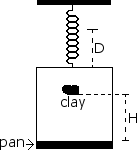Simple Harmonic Motion
An ideal spring is hung from the ceiling and a pan of mass M is suspended from the end of the spring, stretching it a distance D as shown above. A piece of clay, also of mass M, is then dropped from a height H onto the pan and sticks to it. Express all algebraic answers in terms of the given quantities and fundamental constants.
 E. The clay is now removed from the pan and the pan is returned to equilibrium at the end of the spring. A rubber ball, also of mass M, is dropped from the same height H onto the pan, and after the collisions is caught in mid air before hitting anything else. Indicate whether the period of the resulting simple harmonic motion of the pan is greater than, less than, or the same as it was in part (C).
E. The clay is now removed from the pan and the pan is returned to equilibrium at the end of the spring. A rubber ball, also of mass M, is dropped from the same height H onto the pan, and after the collisions is caught in mid air before hitting anything else. Indicate whether the period of the resulting simple harmonic motion of the pan is greater than, less than, or the same as it was in part (C).
 E. The clay is now removed from the pan and the pan is returned to equilibrium at the end of the spring. A rubber ball, also of mass M, is dropped from the same height H onto the pan, and after the collisions is caught in mid air before hitting anything else. Indicate whether the period of the resulting simple harmonic motion of the pan is greater than, less than, or the same as it was in part (C).
E. The clay is now removed from the pan and the pan is returned to equilibrium at the end of the spring. A rubber ball, also of mass M, is dropped from the same height H onto the pan, and after the collisions is caught in mid air before hitting anything else. Indicate whether the period of the resulting simple harmonic motion of the pan is greater than, less than, or the same as it was in part (C).Posted by Fiona Cunningham 6 months ago